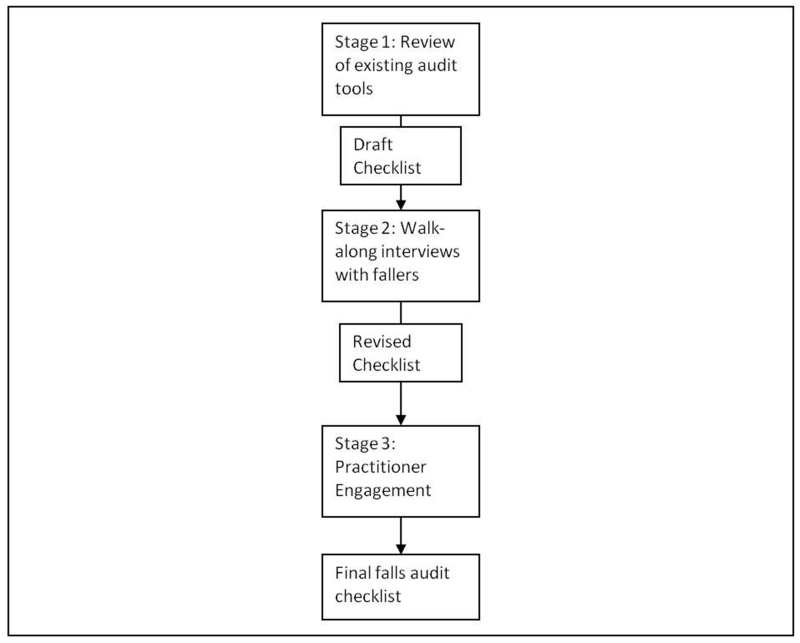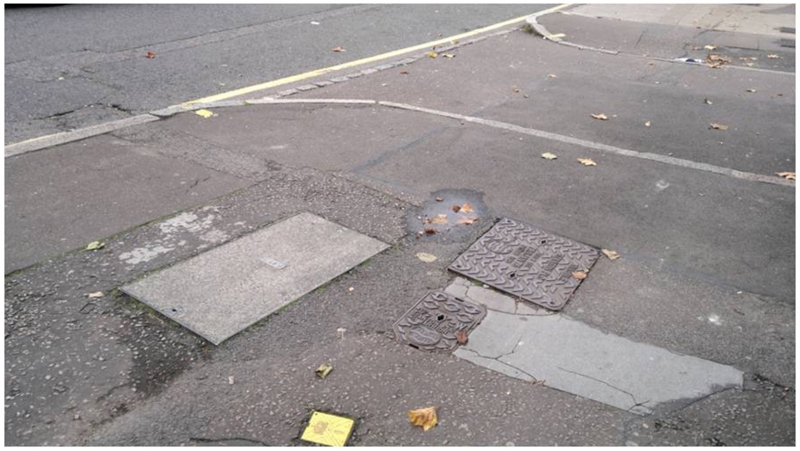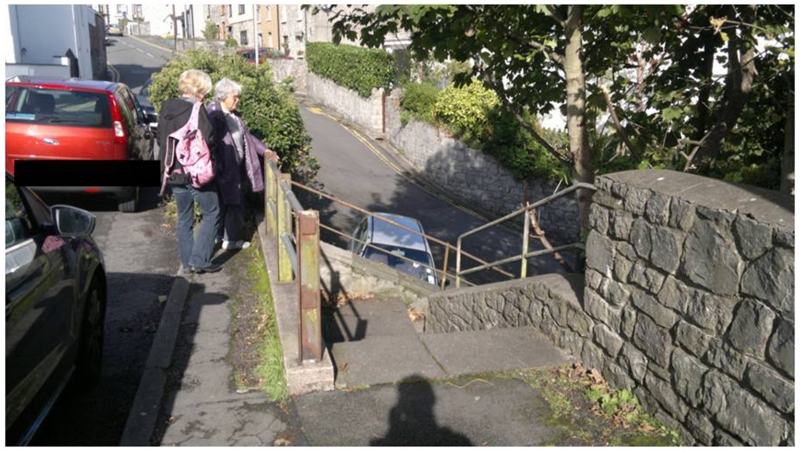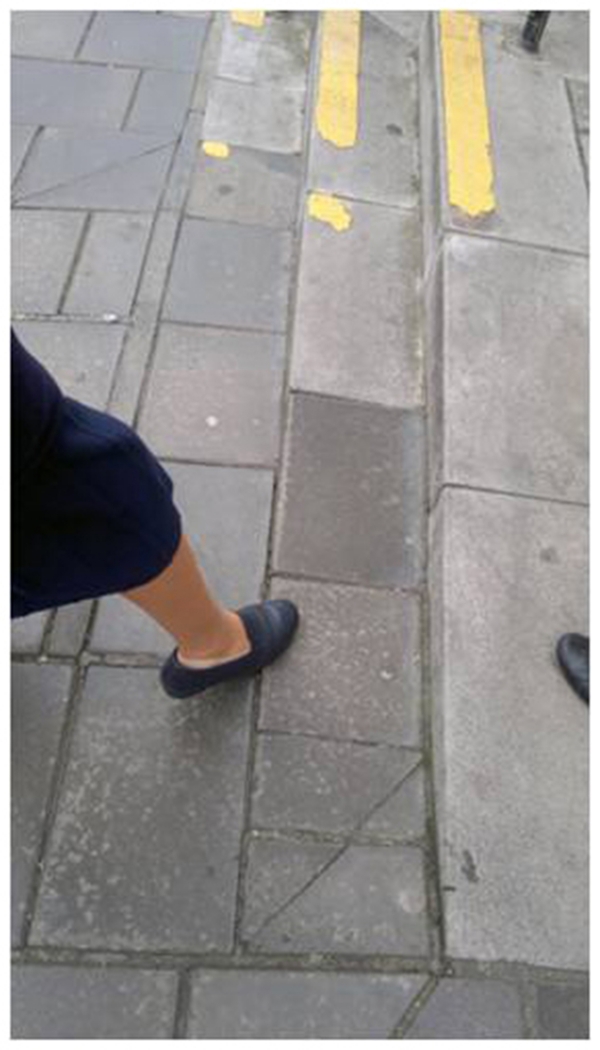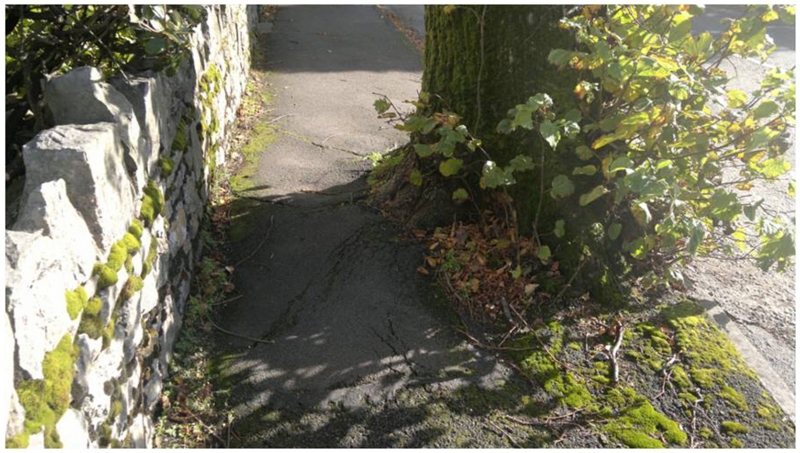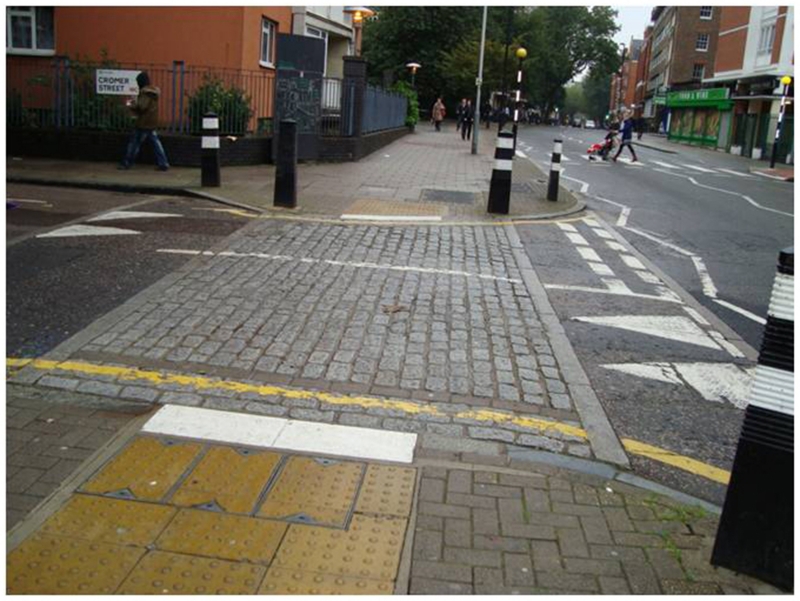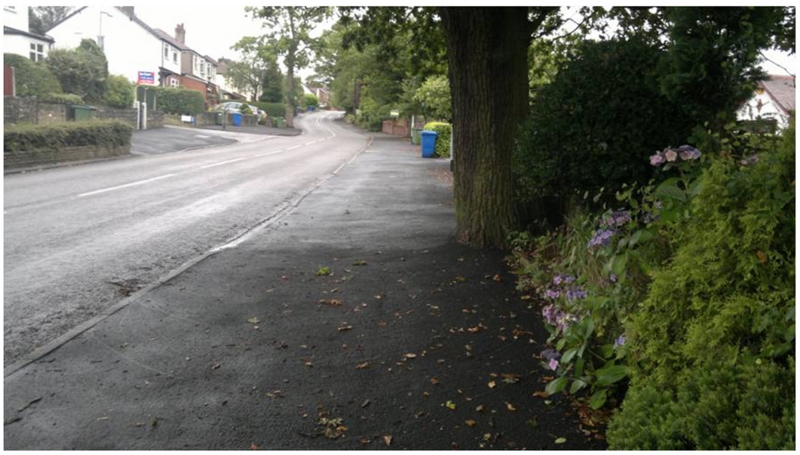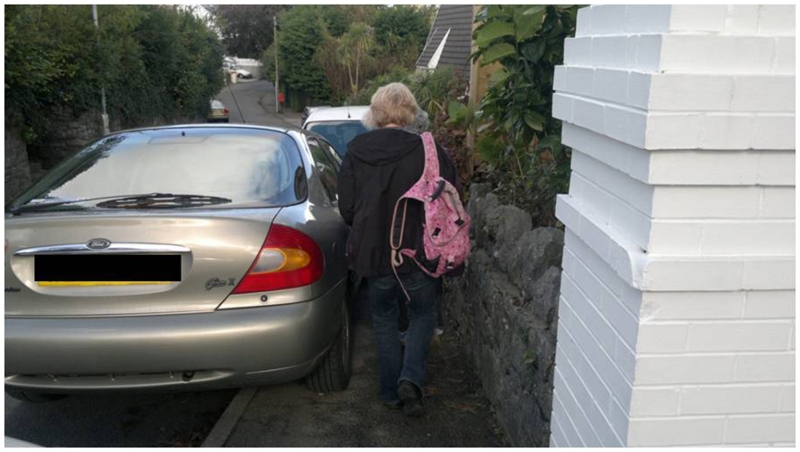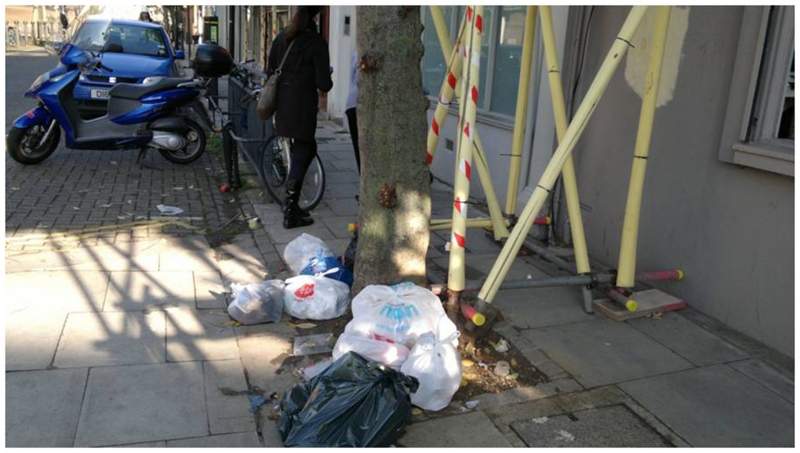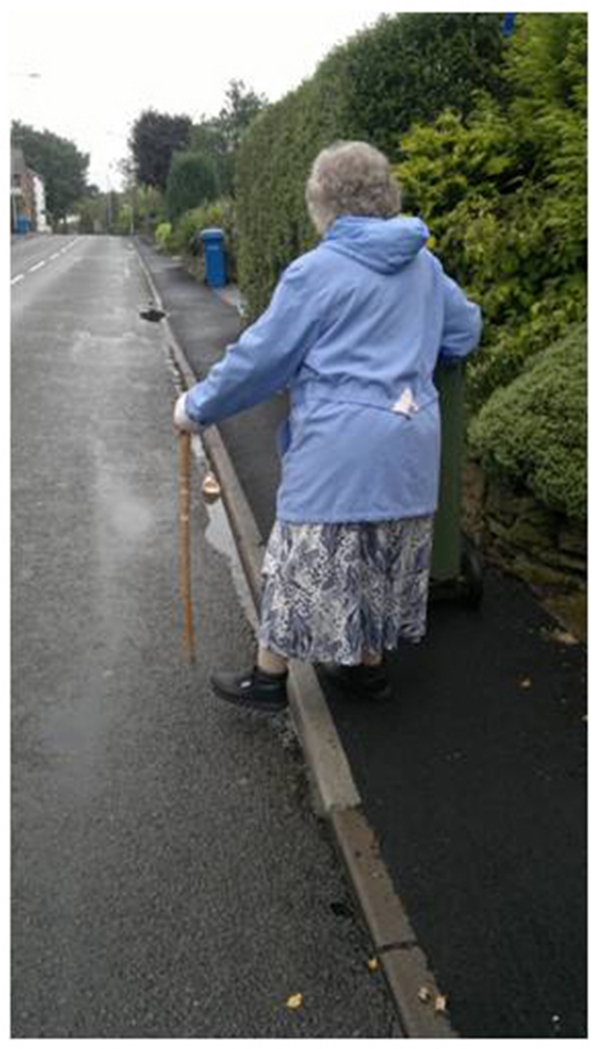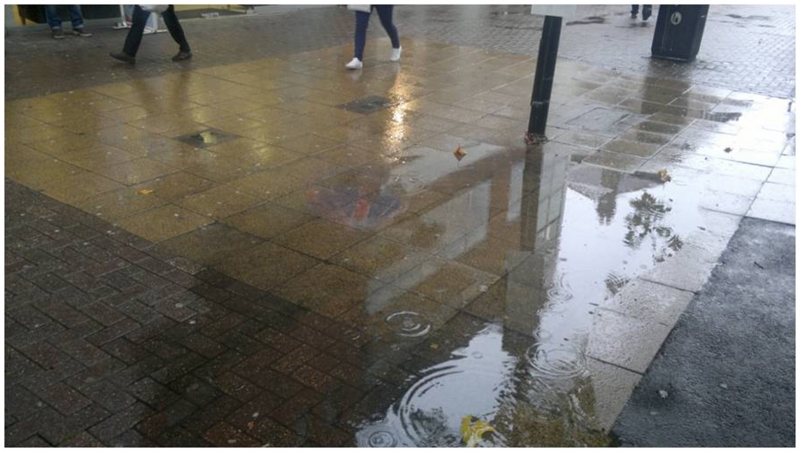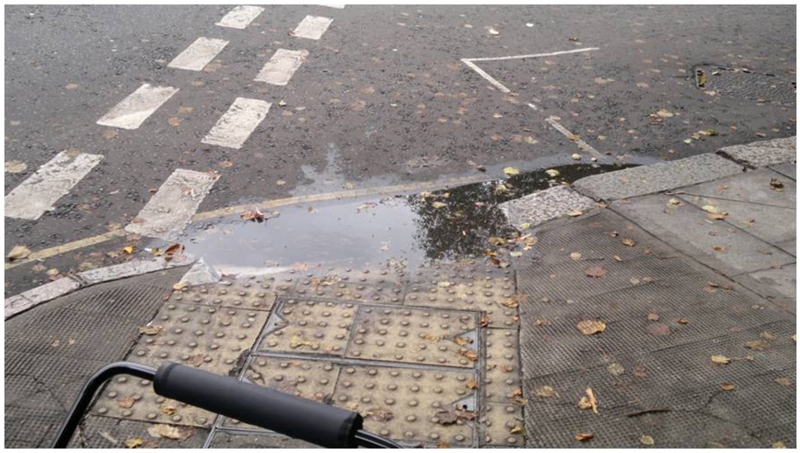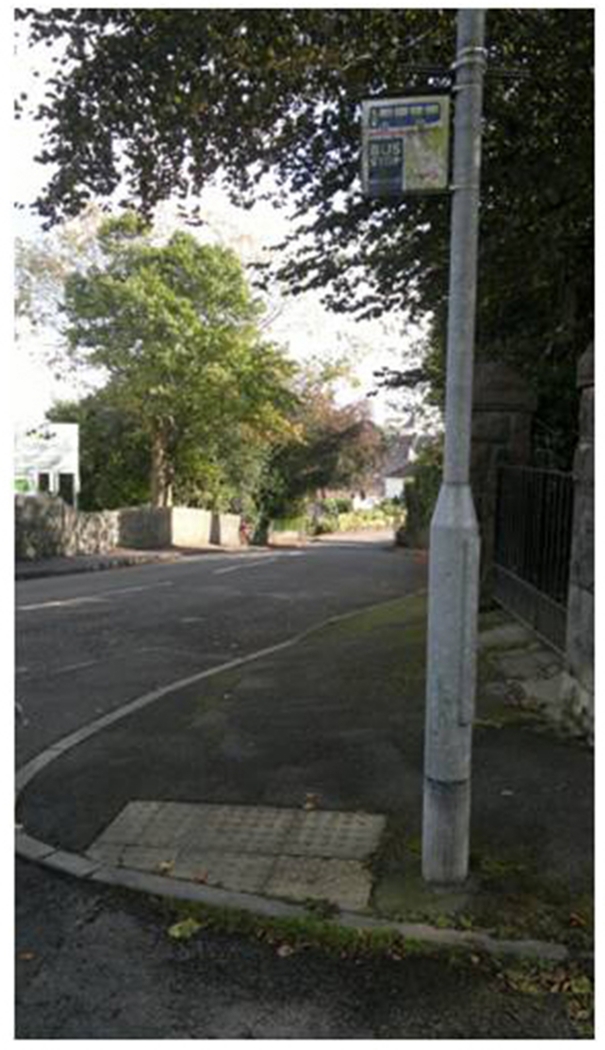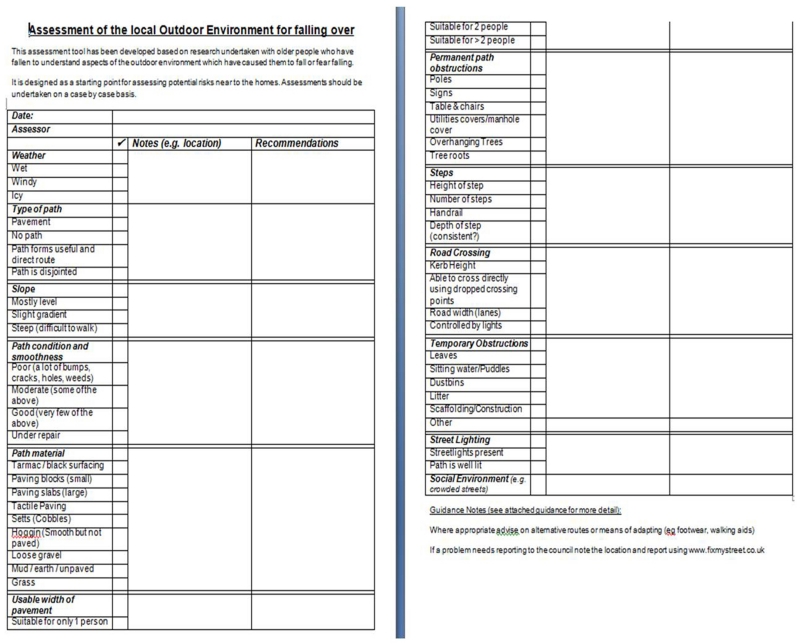Abstract
Falls by older people (aged 65+) are linked to disability and a decrease in mobility, presenting a challenge to active ageing. As such, older fallers represent a vulnerable road user group. Despite this there is little research into the causes and prevention of outdoor falls.
This paper develops an understanding of environmental factors causing falls or fear of falling using a walk-along interview approach with recent fallers to explore how older people navigate the outdoor environment and which aspects of it they perceived facilitate or hinder their ability to go outdoors and fear of falling.
While there are a number of audit checklists focused on assessing the indoor environment for risk or fear of falls, nothing exists for the outdoor environment. Many existing street audit tools are focused on general environmental qualities and have not been designed with an older population in mind. We present a checklist that assesses aspects of the environment most likely to encourage or hinder those who are at risk of falling outdoors, developed through accounting for the experiences and navigational strategies of elderly individuals. The audit checklist can assist occupational therapists and urban planners, designers and managers in working to reduce the occurrence of outdoor falls among this vulnerable user group.
Background
Active ageing remains on the policy agenda, encouraging an ageing population to remain active outdoors and maintain independence for their health and wellbeing. However, older adults who are at risk of falling over outdoors are a vulnerable user group in the urban environment. Falls are the leading cause of hospitalisation in people aged 65+ and of accidental death for the over 75s. Falls present a risk and a threat to the mobility of an ageing population, with 30% of those over 65 falling each year (Skelton and Todd, 2004), and present a considerable burden to the healthcare system, accounting for approximately 10% of ambulance calls (Skelton and Todd, 2004). Although only around 5% of falls result in fracture, the consequences are serious, with approximately half of those who experience a fracture never being a functional walker again and 20% dying within six months. Furthermore, a larger proportion experience soft tissue damage which may also significantly impact upon function, and those who repeatedly fall may experience depression, loss of self confidence, fear of falling, social withdrawal and loneliness (Skelton and Todd, 2004).
There is thus evidence to suggest that falling poses a more general threat to overall quality of life for an older population. Firstly, injury as a result of falling may limit mobility and make it more difficult for people to get outdoors, leading to further decline in physical and mental wellbeing. Secondly, it has been suggested that fear of falling affects quality of life (Perez-Jara et al, 2010) as many people are unhappy being ‘stuck’ indoors but do not leave the house because of fear of falling over (Hjorthol, 2013) It is therefore clear that reducing both incidences of falls and fear of falling is important.
Research exploring the relationship between neighbourhood design and walking in the outdoors is a well established and growing area (Sallis, 2009; Brownson et al, 2009). Although historically walkability studies have not focussed on specific populations, such as older people (Michael et al. 2006), some more recent studies have addressed this (Vine et al, 2012; Ward Thompson et al, 2014; Van Cauwenberg et al, 2012; Grant et al, 2010). Michael et al. (2006) found that the main factors influencing walking for an older population were: local shopping facilities; concerns about traffic; inadequate pedestrian infrastructure; sense of attractiveness and public transport availability. Grant et al (2010) reported the biggest barriers to walking to be hostile environments, particularly road crossings and Nordbakke (2013) cites the most common barriers to walking to be: built-up infrastructure (such as steps and kerbs); anxiety in crowded environments; fear of traffic; potential for accidents and fear of crime.
Older fallers represent a subset of the population who are likely to perceive the environment differently and environmental barriers may both be a direct cause of a fall and exclude those who fear falling from using certain spaces, yet little is known about which features of the outdoor environment present a risk factor for falling (Nyman et al, 2013). Issues of balance, eyesight and physical ability mean that an older population, particularly those who have fallen, may have a specific experience of the outdoor environment which is not accounted for by existing street audit tools and checklists. A greater understanding of features of the outdoor environment which contribute to falls would allow those responsible for the design, management and maintenance of municipal environments to contribute both to reducing the occurrence of falls and to encouraging outdoor activity by enabling those who fear falling to use outdoor space with greater confidence.
Outdoor falls have been called a neglected public health problem, occurring at least as often as indoor falls (Li et al, 2006). According to Li et al (2006) up to three quarters of falls are precipitated by poor environmental conditions, mainly tripping and slipping on uneven or wet surfaces. Based on focus group research, Nyman et al (2013) classify environmental causes of falls into tripping hazards, uneven or poorly maintained pavements, dogs (pulling or running in front of a person), weather and loud noises. Using a spatial approach to identifying where outdoor falls occur, Lai et al. (2009) found junctions, wet surfaces, crowds and uneven and mixed surfaces in areas where there was a large concentration of falls.
A number of audit tools designed to assess the walkability of the outdoor environment already exist (Millington et al, 2009; Leslie et al, 2007; Pikora et al, 2002) and some are specific to an older population (Cunningham et al, 2005; Michael et al, 2009) but none specifically address features of the environment which are likely to cause problems for those at risk of falling. There have been calls for public health professionals to consider outdoor as well as indoor falls (Nyman et al, 2013) in order to develop tailored falls prevention plans (Scott et al, 2003) but at present there is limited evidence of the environmental causes of outdoor falls and therefore practitioners find it hard to advise older people on outdoor risk factors.
In contrast, there is a large body of research into the causes of indoor falls. Furthermore, there are existing audit tools and checklists designed to assess the indoor environment for risk of falls, but there are no audit checklists assessing the outdoor environment specifically for falls risk. Studies of falls risk factors tend to focus on the individual and their functional limitations (Yamashita et al, 2012). Fear of falling inside the home is usually assessed using a scale such as the Falls Efficacy Scale International (FES-I ) (Yardley et al, 2005) which assesses people’s fear of falling in relation to undertaking the following typical day to day activities: cleaning the house; getting dressed/undressed; preparing simple meals; taking a bath or shower; going to the shop; getting in or out of a chair; going up or down stairs; walking around outside; reaching up or bending down; answering the telephone; walking on a slippery surface; visiting and friend/relative; going to a place with crowds; walking on an uneven surface; walking up or down a slope, and; going out to a social event. Given that outdoor fallers tend to be younger and more active (Bath and Morgan, 1999; Li et al, 2006) these items may be inadequate for assessing outdoor falls. Hill et al. (1996) added four outdoor items to the FES-I: using public transport, crossing the road, light gardening or hanging out washing and using the front or rear steps at or near home. While these scales assess the fear of falling for an individual based on their capabilities, it provides limited understanding of environmental features which may enable or deter them from doing such activities outdoors. Furthermore, while risk factors for indoor falls are usually health-based (Bath and Morgan, 1999), the environment may play a greater role in outdoor contexts. Iwarsson et al, (2009) and Connell and Wolf (1997) have focussed on the interaction of the environment and the individual for indoor falls and such an approach may be particularly relevant for outdoor falls
The concept of Environmental Support, focussing on environmental quality in relation to desired activities, is central to our approach. Lawton and Nahemow (1973) developed an Ecological Model of Ageing that introduced the concept of environmental press – the differential effect of the environment on behaviour that relates to the capabilities and characteristics of the individual. Building on this and the transactional relationship between people and place, models of environmental fit (Lawton, 1980; Kahana, 1982; Carp and Carp, 1984) have been developed to describe how the environment can become a limiting factor on people’s mobility as their functional capabilities change in old age (Iwarsson, 2005). Related to this, the concept of environmental support draws on the work of Kelly (1955) and Little (1983) to focus on environmental quality in relation to desired activities, especially for an ageing population. Environmental supportiveness is seen as the extent to which the environment supports or hinders physical activity (Sugiyama and Ward Thompson, 2007a; Sugiyama and Ward Thompson, 2007b) . As a concept, it links environmental attributes with people’s perceptions of them in relation to their own, idiosyncratic, desired and necessary activities. We sought to develop a checklist that assesses aspects of the environment most likely to encourage or hinder those who are a risk of falling outdoors through a focus on person-environment fit. Iwarsson et al (2009) found that using a person-environment fit approach led to a better prediction of indoor falls than focussing solely on environmental factors.
Although people of all ages may fall over as a result of a poorly maintained or designed environment, older adults are a vulnerable user group due to the heightened risk, both of falling in the first instance and of subsequent injury. Furthermore, the psychological effects of falling over may inhibit outdoor activity and mobility of older people, given that fear of falling is associated with going outdoors less often and the biggest causal factor for fear of falling is having experienced a prior fall (Scheffer et al, 2008). An understanding of the environmental causes of falls in an ageing population is therefore vital for inclusive design, planning and management of the urban environment, with potential to improve quality of life for this growing demographic.
Based on this, drawing together the fields of public health and urban design, we develop an audit checklist designed to assess the outdoor environment for falls risk, identifying features which may cause falls or fear of falling, drawing on the experiences of older adults who have fallen. In the methodology section we present the approach to developing the audit checklist. The results section consists of the identification of aspects of the environment likely to cause falls or fear of falling, followed by the checklist itself, and finally we discuss potential uses and limitations, given that reducing the risk of falling and encouraging older people to remain active outdoors is important to both public health and urban environment professionals.
Methods
This section describes the approach taken to developing an audit checklist. Checklist development followed a three stage process, as shown in Figure 1. Firstly, based on a review of existing street audit tools and a review of the falls literature, summarised above, we produced a draft checklist consisting of environmental features which it was anticipated might present a problem to an older population in general and specifically those who had fallen, or are at risk of falling, outdoors. We defined ‘older people’ as those aged 65 or older. We used the Scottish Walkability Assessment Tool (SWAT) (Millington et al, 2009) as a starting point for our audit checklist. Tools such as this collect detailed environmental information, which was useful to ensure we were not omitting consideration of anything potentially relevant in the UK context. However, our aim was to build a checklist drawing on the experiences of those who had fallen, rather than external auditors, and therefore our method sought to move beyond this long and detailed checklist to a more parsimonious list which was nonetheless relevant to older people’s experience and relevant to those charged with assessing falls risk.
Figure 1. Development of Audit Checklist.
‘Go-along’ walking interviews
We undertook accompanied walks with 20 older adults (65 and over) who had experienced a fall in the previous 12 months. The ‘go-along’ method was used, combining ethnographic participant observation with interviewing (Carpiano, 2009) to gain the perspectives of older people who have fallen over on their experiences of the outdoor environment. This approach is particularly suited to environmental perception (Kusenbach, 2003).
We used a convenience sample, recruited from those had already participated in a focus group about falling outdoors (Nyman et al, 2013) and were recruited based on having experienced a fall during the previous year and their willingness to participate in further research.
Although some of our participants had experienced fractures and bruising, the majority of participants had not sustained long-term physical injuries from their fall, but many were affected emotionally. We recognise the limitation of interviewing using such a convenience sample and the potential bias from interviewing only those still able to walk about, albeit in some cases using a walker or rollater. However, given the emphasis on the environment, rather than trying to understand all impacts of the fall, our sample was by necessity still relatively mobile. We sought to select participants across a spectrum of geographical areas, functional status, gender and age groups. Demographic characteristics of participants are included in the results section. Our study was limited to a 12-month period, with only one opportunity for undertaking interviews. The interviews took place in Autumn 2012 across four UK cities: London, Edinburgh, Salford and Swansea. Temperatures were mild (10-15 degrees centigrade) and we experienced some light rainfall.
We interviewed 17 women and 3 men with a mean age of 77 (sd=6.71). It was challenging to recruit men to the study as has been previously discussed (Nyman et al, 2013) and this is a limitation of the study. We used an Instrumental Activities of Daily Living Scale (IADL) based on Jette et al (1986) to assess functional status. We asked respondents to rate the level of difficulty (1-5) experienced undertaking the following activities: seeing for reading; seeing for getting around; hearing; remembering things; getting around; and to rate how hard (1-5) they find it to: walk 500 yards; climb stairs; do housework; do errands; use public transport; do physical activity. IADL scores ranged from 1-3.45 (out of a possible 5) with 1 representing the highest level of function and the mean score across items being 1.86 (sd=0.79).
To help determine the route of the walk, participants completed a short questionnaire before the walk to collect demographic data and information about their day to day activities using a personal projects approach (Little, 1983; Wallenius, 1999). Personal projects are used to elicit the kinds of outdoor activities participants undertake and were used help determine the route of the walk by walking to one of the places listed in the personal projects section, following the methodology of Van Cauwenberg et al (2012) who used pre-information on participants’ daily activities to help decide the route. An alternative option would have been to walk participants on the same route to understand how different individuals assess the same route, which would have resulted in a detailed audit of a particular environment, reflecting the variation among participants’ perceptions as well as validating items within a controlled environment. However, our interest lay more in taking participants on a walk familiar to them and understanding which environmental features they perceive to be beneficial or deterring in a familiar and comfortable environment. Given that unfamiliar environments result in a increased falls risk (Phillips et al, 2013), and all of our participants had previously fallen, it was deemed preferable to undertake the research in familiar environments. Nonetheless, to reduce undue stress on participants, a pre-determined route was prepared in case they could not easily decide on a route but, in the event, this was not required by any of the participants. Photographs were taken during the walks as appropriate to show areas participants highlighted as particularly positive or negative. The interviews were audio and GPS recorded and transcribed verbatim. The mean walk length (measured using GPS tracking) was 0.82 miles (sd=0.45), taking 25.1 minutes (sd=10.92).
Development of Audit Checklist
As outlined above, the development of the checklist was undertaken in a number of stages, drawing upon the results of go-along interviews to determine items for inclusion in the audit checklist. Analysis of the accompanied walks was undertaken in two stages. Firstly, transcripts were scanned and a matrix of interviewees’ comments against factors identified in the draft audit checklist was completed. During this stage additional environmental factors mentioned by interviewees were added to the matrix. This was completed twice, firstly for factors which had caused a fall and secondly those which were identified as potentially problematic or causing a fear of falling among participants. The factors identified both in the draft checklist and initial scan of interview transcripts were then used to create a coding framework. Interview transcripts were subsequently coded by the researcher in more depth according to this framework and then we revisited the spreadsheet matrix to highlight environmental features identified as positive or negative by each of the participants. Following this, the draft checklist was revisited to ensure that those things mentioned most by interview participants were included. Those that featured most prominently were then retained to create a parsimonious checklist reflecting aspects of the environment most likely to contribute to falling, or fear of falling.
The final stage in the development of the checklist was a workshop held with healthcare practitioners usually involved in assessing the home for falls risks. Practitioners were mainly National Health Service (NHS) healthcare workers or local authority falls practitioners and were recruited through Age UK, an older people’s charity who run a range of similar events for professionals. We discussed the revised checklist with them to establish how it could be improved to make it useful and straightforward to use for practitioners. We used the workshop firstly to discuss in more depth some of the environmental factors causing falls and fear of falling, using photographs taken during the accompanied walks as a guide. Secondly we discussed the checklist in terms of the items included and, crucially, how falls practitioners would envisage using such a checklist and how it might be useful to them.
Results
Results are presented in three stages. Firstly we present the environmental barriers for older fallers, identified from the interviews, then we present the results from engagement with healthcare practitioners. Finally we present the audit checklist.
Environmental barriers for older fallers
In this section we describe the environmental features included in the checklist. These were derived using the process described in the methods (Figure 1). We describe how each of the environmental barriers influences falling or fear of falling.
Changes in level
Changes in level stand out as the one most significant environmental features affecting the experiences of those who have fallen and being perceived to have caused falls. These could take the form of kerbs, slopes or steps, or more unexpected changes in levels such as uneven paving. Almost all of the participants felt they had fallen due to tripping over uneven ground. Further to this, they now saw changes in levels as problematic and this had led to a heightened level of concentration required whenever they are walking. Changes in levels may be substantial, for example steps or kerbs, or less substantial, such an uneven paving, drains or manhole covers. Figures 2, 3 and 4 show some examples of changes in levels which were highlighted by our participants. It was noted that the tolerance level for uneven flags of up to 25mm vertical difference is not suitable for older people, who have more problems with balance and are unable to lift their feet as far from the ground, meaning that even the smallest of changes in level as a result of uneven paving flags can present a hazard.
Figure 2. Changes in levels - drain across pavement.
Figure 3. Changes in levels due to manhole covers.
Figure 4. Changes in levels – steps and slops.
As shown in Figure 4, changes in levels may be sudden or more gradual. Slopes, as well as steps, present a problem. It must be noted, however, that each individual usually had a preference for one over the other, depending on individual capabilities. It is therefore difficult to suggest that either ramps or steps are preferable to those at risk of falling, but rather that an inclusive environment would include both options for changing levels.
Tapered steps such as those in Figure 5 present a particular challenge due to the variable rise in height along the length, which may be especially difficult for those with poor eyesight.
Figure 5. Changes in levels – tapered steps require greater concentration and are a source of stress.
Path condition and smoothness
The condition and smoothness of paths was mentioned by almost all participants. This is related to changes in levels as previously discussed. Poorly maintained pavements cause trip hazards as a result of changes in levels. Older adults are likely to experience changes in gait affected partly by a decreased range of ankle motion (Spink et al, 2011), affecting their ability to navigate uneven pavements. Further to this, those who have fallen and those who are struggling with balance are likely to lift feet a lower height from the ground, meaning that uneven pavements which might easily be navigated by a more mobile person present a threat to those at risk of falling. Figure 6 and Figure 7 show examples of varying path conditions, all of which present a threat.
Figure 6. Cracked paving flag and wet conditions.
Figure 7. Bitumen surface made uneven by tree roots.
Path material
The majority of participants referred to the surface material of paving as being influential in how they perceived the environment. Setts (cobbles) and flags (paving stones) were problematic for many because they are more likely to be uneven and setts, in particular, are likely to be slippery. Of particular note is tactile paving, designed to denote the presence of a crossing point for those with poor eyesight or visual impairment, but which, for those who are unsteady on their feet, can be both uncomfortable and cause imbalance (see Figure 9). Most of our participants mentioned blacktop/bitumen as favourable for being slip resistant and less likely to be uneven (see Figure 8), although this is not always the case, as seen in Figure 7.
Figure 9. Tactile paving and setts are uncomfortable and can lead to imbalance.
Figure 8. most partcipants said bitumen was the most comfortable surface to walk on.
Obstructions
Obstructions along a route can cause loss of balance, create uncertainty or cause detours which may result in falling. Obstructions may be permanent, such as fixed rubbish bins and benches, or temporary such as vehicles, dustbins, litter or billboards (see Figures 10, 11 and 12). Obstructions present various kinds of hazard. Examples from our interviews include a slip hazard caused by vegetable peeling, having to manoeuvre around vehicles or dustbins, or feeling uneasy because of streets crowded with people. This highlights how obstructions can be dynamic and that the social environment is also an important factor in assessing falls risks, as has previously been highlighted (Nordbakke, 2013).
Figure 10. Temporary Obstruction – parked vehicles.
Figure 11. Multiple Temporary Obstructions – Litter, scaffolding, parked bicycle.
Figure 12.
Temporary Obstruction causing change of route and change in levels
Road crossing
Rushing and lack of concentration were often cited reasons for the cause of a fall, meaning that the type of road crossing can be important for how fallers perceive the environment. Crossing the road requires additional concentration and often involves rushing to cross during the pedestrian phase, which is frequently not long enough for older people (I’DGO, 2013). Other research (Lai et al, 2009; Nyman et al, 2013; Hill et al, 1996) has identified traffic, or fear of traffic, to be a major risk factor for falls, although this was not frequently mentioned by our participants as busy roads were avoided where possible, so we did not necessarily encounter them on go-along interview walks.
Street Lighting
We did not anticipate street lighting to be directly related to falling, but found that the available light could cause distractions and therefore reduce the level of concentration. One participant talked about how shadows were distracting and she could not tell whether there was a shadow or a step, making it hard to negotiate the environment or anticipate obstacles. Related to this, eyesight was mentioned by a number of participants as affecting their ability to get about with confidence. Environments sensitive to those with visual impairment are therefore important in reducing falls-risk.
Weather
The weather is a dynamic factor, having a significant impact on falls and falls risk. As shown by Figure 13 and Figure 14, if the street environment is not designed or maintained well then, during certain weather conditions, falls risk can be enhanced, as certain surfaces will become slippery and people may have to detour. Icy conditions in particular are likely to lead to an increased falls risk. Windy conditions can also cause imbalance problems for older people. Urban environments should be designed to ensure that wind tunnels are not created by tall buildings, taking into account the direction of prevailing winds.
Figure 13. Accumulation of water during wet weather conditions may increase slip risk.
Figure 14. Uneven pavement and accumulation of water makes this road crossing challening.
So far we have reviewed some of the main environmental attributes which were highlighted by our participants as having resulted in falls and leading to a fear of falling. However, these are rarely a problem in isolation; rather, multiple factors frequently interact to cause falls or fear of falling. Figure 15, for example, shows an example where path material (tactile paving), slope and poor maintenance (leaves and moss) combine to create a difficult environment.
Figure 15. Multiple hazards – slope, tactile paving surface, moss and road crossing.
Engagement with healthcare practitioners
During our workshop with falls practitioners, there was general agreement that items included in the checklist we presented were sufficient to be useful and reasonably comprehensive, although a few suggestions were made. In general the idea of a checklist similar to those currently used inside the home was welcomed, although it was stressed that falls practitioners would need training and guidance on how to use the checklist and what follow-up actions could be taken. There was a general consensus that the outdoor environment is not considered as much as the indoor environment by falls practitioners but that it is an important aspect that deserves more attention.
We made a number of improvements to the proposed audit checklist following engagement with practitioners. We changed the ‘path material’ section to include non-technical language, for example ‘cobbles’ instead of ‘setts’, as health practitioners are unlikely to be familiar with the technical terms. Following the workshop we also added space for notes, so that, where a problem exists, it can be highlighted or more relevant details provided.
In our discussions, both with older participants and professionals, it was highlighted that dynamic factors such as the weather are important but difficult to include in the audit as they are so variable. However, we have included the weather in our audit checklist as some of the environmental features will be more of a hazard during particular weather conditions. Recording the weather therefore acts as a reminder that the audit was undertaken under particular conditions and can remind auditors to consider what the situation would be under differing weather conditions.
Some of the practitioners said that they already, informally, assess the outdoor environment on a case-by-case basis and echoed our conclusion that there cannot be a ‘one-size fits all’ approach to what affects each individual’s access outdoors. However, it was recognised that a checklist could be a useful starting point, especially for training new occupational therapists if there were moves towards assessing the outdoor environment as standard practice. Practitioners also informed us that, in some areas, they do outdoor walking practice with those who have fallen and they suggested that the checklist would be very useful to assist them with this and highlight the key things to be aware of. Those who did not currently assess the outdoor environment said they would take our findings back to colleagues and suggest incorporating outdoor audits.
The importance of ensuring that action is taken where problems are identified was emphasised. Some felt that, in the case of problems with public provision such as pavements or footways, if they knew the council website and there was an easy form to complete to register a problem, then it would not be too difficult for them to report issues such as uneven pavements, but others felt this was beyond their remit. This led us to including the recommendation to report issues using ‘fixmystreet’ (www.fixmystreet.com) which does not require searching through individual council websites but sends reports relating to poor pavements, etc., direct to the relevant council. This clearly only serves a UK context but is particularly important as UK health board areas do not match council areas, so an occupational therapist may be working across several local authorities and not always know which one is appropriate to approach for any given patient.
Audit Checklist for assessing outdoor falls risk
In this section we present the audit checklist, Figure 16, designed to be used by occupational therapists and other professionals working with older people at risk of falling, in order to help them navigate the urban environment, as well as urban designers and planners creating outdoor places, and . those responsible for managing and maintaining municipal services.
Figure 16. Proposed Audit Checklist.
Advice from the falls practitioners was to create a short, two-sided checklist that was easy to use and not weighed down with the minutiae of detailed guidance, dimensions so as to became unworkable.
When considering use of the checklist by occupational therapists, in our experience with participants, environmental awareness was high following a fall. Older people themselves may be best at knowing what they should avoid and strategies to avoid falling again; however, for those who have fallen, a walk and a chance to discuss issues with a qualified professional is likely to give them renewed confidence. Additionally, for a person who is at risk of falling (because of health conditions), the audit checklist would be useful to identify potential barriers and strategies for going outside.
Beyond this, the audit checklist offers those responsible for the urban realm an aid to ensuring that environments are designed with older people and falls prevention in mind.
Figure 16 shows the revised audit checklist following accompanied walks and discussion with falls practitioners. The guidance sheet giving information on how to complete the checklist is provided in the Appendix.
Discussion and Conclusions
Falling and fear of falling threaten the ability to get outdoors and maintain quality of life for older adults. Our audit checklist serves a number of purposes. For those who have fallen in the past, the audit checklist is designed to be used to build a picture of an individual’s environment, to identify risk factors and to help decide the best way to prevent or minimise future falls. It also offers opportunities to prevent falls for older people moving into new and unfamiliar environments. For those who fear falling, being able to go on a walk with a qualified professional and audit their local environment may give them the confidence and familiarity to remain active outdoors. This may be particularly useful at the point when people move house, perhaps into assisted accommodation in an unfamiliar area. Recent research (Phillips et al, 2013) has highlighted the heightened cognitive load associated with being in unfamiliar environments. Using our checklist may therefore assist in developing familiarity, with a specific focus on environmental attributes which contribute to falling and fear of falling.
Trips, slips and loss of balance are the main causes of falls (Bath and Morgan, 1999; Scheffer et al, 2008) and there are several aspects of the environment which make these more likely. As we have identified, this includes changes in levels, path material and condition, types of road crossing and street lighting. The weather is also important and, while designers do not have control over this, the urban environment should be designed with weather conditions in mind so as not to create slip hazards due to accumulated water or wind tunnels which may lead to loss of balance. Tall buildings, in particular, an increasing feature of inner urban areas, can lead to wind turbulence and funnelling, and add to the challenge of negotiating outdoor environments. During our interviews, participants often talked about the level of concentration required to navigate the environment, even a familiar one. Environments therefore need to be not too complex to navigate in order to reduce cognitive load and reduce the likelihood of falling due to an inability to concentrate.
Given the dearth of research into the causes of outdoor falls, we believe this makes a useful contribution by highlighting the most pertinent environmental features which may lead to falls or fear of falling. The audit tool is also relevant, therefore, to those responsible for providing and managing municipal services and, in particular, the public realm of outdoor streets and spaces. The key points highlighted as problematic for older fallers should be considered at the design stage, thus reducing the need to mitigate risk further down the line. However the features identified may also allow planners and managers to prioritise remedial work to the environment and ensure that quality of materials and levels of maintenance are appropriate.
We recognise several limitations inherent in the use of any such checklist, not least that there cannot be a tool which will give due weight to all aspects of the environment as they are perceived by each individual. In this vein, we designed the checklist not to be an assessment of the environment per se, but to be used by occupational therapists, alongside individuals at risk of falling, in order to highlight areas where falls risk may occur and, where appropriate, report poorly maintained or poorly designed streets to the relevant body. While the audit checklist may not contain any surprises in terms of the environmental features included, it is useful as a starting point for those with little awareness of what may contribute to outdoor falls, given limited research in this field to date.
Assessing the outdoor environment for falls risk focuses on more micro-environmental assessment than a walkability measure, for example, which may also consider proximity of destinations. We have not considered this aspect of a walkable environment in developing the checklist. However, neighbourhood walkability is also of potential importance for falls at a different scale, as shorter distances may reduce the likelihood of falling over; however it was not highlighted as an immediate concern among participants.
The analysis presented here relates purely to the identification of environmental features for the development of an audit checklist. However, analysis of the go-along interviews shows that participants’ relationship with the environment is complex and we intend to publish a subsequent paper exploring the experiences of older fallers in more depth. Participants often discussed the decisions they made in determining which way to go or how to negotiate a certain environment, for example choosing a steeper route with fewer fallen leaves, or a longer way around to avoid steps, or a busy road. This highlights the potential for future research to use techniques such as choice-based conjoint analysis to further understand the factors influencing fear of falling in an older population.
It is difficult to encapsulate the variety of experiences and numerous ways in which older fallers experience and relate to the environment in an audit checklist, which is by nature reductionist. The audit checklist therefore highlights the main environmental attributes most likely to hinder or support this particular user group. However, as outlined in the introduction, our approach based on person-environment fit recognises that individuals interact with and perceive the environment differentially, so identification of features presenting a falls risk may often be contradictory, meaning it is difficult to make design recommendations. However, taking the results we have presented here can help urban designers and planners ensure that the environment is designed and managed in an inclusive manner by offering options to those with different needs and preferences.
Audit checklists in general can be criticised for not being explicit on how the data are subsequently used to inform practice. By contrast, this checklist was designed with a practical purpose in mind, not to collect detailed data about the environment, but as a guide for occupational therapists and built environment professionals. Future research should seek to develop a validated tool for measurement by taking our checklist items and checking inter-rater and intra-rater reliability for specific street segments and by undertaking a quantitative analysis of the environmental features we have identified for predicting outdoor falls.
Practical relevance and potential applications of the checklist for Urban Planners, Designers and Managers, and for Occupational Therapists
This checklist provides two differing functions within the same document. For built environment professionals, including urban designers and planners, as well as highways and civil engineers, landscape architects, municipal authorities and city centre managers, it forms an aide memoire of the elements that are critical within the outdoor environment to minimise the risk of falls by older people. Using this checklist it is possible to focus in on what in the environment are likely to be the major concerns of those with a fear of falling, and to then look for better practice solutions. For occupational therapists it provides support for a process to go beyond the garden gate of an individual and explore the outdoor goals a person might have, and then use the checklist to identify routes that avoid potential hazards. Importantly, the elements identified are evidenced via a research process that ensures they reflect the real concerns of those who have fallen and now have a fear of falling.
Falls practitioners and occupational therapists engaged in the research process were enthusiastic about a checklist that was easy to understand and use. However, how best to feed information on environmental problems noted from the using the checklist back to those with a potential to resolve the issues remains a work in progress. Other parts of this research project have been investigating a “Stop that Fall” website that would enable information from the checklist to be directed to the relevant places and professionals, to try to prevent further falls in a manner that moves away from insurance claims drivers towards more positive ways to improve our outdoor landscape. What has become apparent from this research on the outdoor, urban environment is that we need to join up the contribution of disparate professionals - falls practitioners and occupational therapists with urban designers and civil engineers, for example - to find ways to flag up potential fall hazards and rectify them expediently.
Supplementary Material
Acknowledgements
This research was funded through the Medical Research Council (grant reference G1002782/1) as part of the Lifelong Health and Wellbeing (LLHW) Cross-Council Programme. The LLHW Funding Partners are: Arts and Humanities Research Council, Biotechnology and Biological Sciences Research Council, Engineering and Physical Sciences Research Council, Economic and Social Research Council, Medical Research Council, Chief Scientist Office of the Scottish Government Health Directorates, National Institute for Health Research/The Department of Health, The Health and Social Care Research and Development of the Public Health Agency (Northern Ireland), Wales Office of Research and Development for Health and Social Care, and the Welsh Assembly Government. The LLHW programme and funding partners had no role in the design, collection, analysis, or interpretation of data; in the writing of the manuscript; or in the decision to submit the manuscript for publication. We are grateful to the following: Harriet Hogarth for providing participant contact details from the focus group study and for transcribing the interviews; Carol Maddock, Eva Silveirinha de Oliveira, Rick Houlihan and Chantelle Anandan for assistance with interviews. We are also grateful to the older people that gave their time for this study
Contributor Information
Angela Curl, Urban Studies, University of Glasgow, Glasgow, UK.
Catharine Ward Thompson, OPENspace Research Centre, Edinburgh College of Art, Edinburgh, UK.
Peter Aspinall, School of the Built Environment, Heriot-Watt University, Edinburgh, UK.
Marcus Ormerod, University of Salford, Salford, UK.
References
- Bath PA, Morgan K. Differential risk factor profiles for indoor and outdoor falls in older people living at home in Nottingham, UK. European journal of epidemiology. 1999;15(1):65–73. doi: 10.1023/a:1007531101765. [DOI] [PubMed] [Google Scholar]
- Brownson RC, Hoehner C, Day K, et al. Measuring the built environment for physical activity: state of the science. American journal of preventive medicine. 2009;36(4 Suppl):S99–123. doi: 10.1016/j.amepre.2009.01.005. [DOI] [PMC free article] [PubMed] [Google Scholar]
- Carp FM, Carp A. A complementary/congruence model of well-being or mental health for the community elderly. Human Behavior and Environment: Advances in Theory and Research. 1984;7:279–336. [Google Scholar]
- Carpiano RM. Come take a walk with me: the “go-along” interview as a novel method for studying the implications of place for health and well-being. Health and place. 2009;15(1):263–72. doi: 10.1016/j.healthplace.2008.05.003. [DOI] [PubMed] [Google Scholar]
- Van Cauwenberg J, Van Holle V, Simons D, et al. Environmental factors influencing older adults’ walking for transportation: a study using walk-along interviews. The international journal of behavioral nutrition and physical activity. 2012;9(1):85. doi: 10.1186/1479-5868-9-85. [DOI] [PMC free article] [PubMed] [Google Scholar]
- Connell BR, Wolf SL, Atlanta FICSIT Group Environmental and behavioral circumstances associated with falls at home among healthy elderly individuals. Archives of physical medicine and rehabilitation. 1997;78(2):179–86. doi: 10.1016/s0003-9993(97)90261-6. [DOI] [PubMed] [Google Scholar]
- Cunningham G, Micheal Y, Farquhar S, Lapidus J. Developing a reliable Senior Walking Environmental Assessment Tool. American journal of preventive medicine. 2005;29(3):215–7. doi: 10.1016/j.amepre.2005.05.002. [DOI] [PubMed] [Google Scholar]
- Grant TL, Edward N, Sveistrup H, et al. Neighborhood walkability: older people’s perspectives from four neighborhoods in Ottawa, Canada. Journal of aging and physical activity. 2010;18(3):293–312. doi: 10.1123/japa.18.3.293. [DOI] [PubMed] [Google Scholar]
- Hill KD, Schwarz J, Kalogeropoulos A, Gibson S. Fear of falling revisited. Archives of physical medicine and rehabilitation. 1996;77(10):1025–9. doi: 10.1016/s0003-9993(96)90063-5. [DOI] [PubMed] [Google Scholar]
- Hjorthol R. Winter weather – an obstacle to older people’s activities? Journal of Transport Geography. 2013;28:186–191. [Google Scholar]
- IDGO The Design of Streets with Older people in Mind: Pedestrian Crossings. Inclusive Design for Getting Outdoors. 2013 http://idgo.ac.uk/pdf/PedestrianCrossings.pdf.
- Iwarsson S. A Long-Term Perspective on Person–Environment Fit and ADL Dependence Among Older Swedish Adults. The Gerontologist. 2005;45(3):327–336. doi: 10.1093/geront/45.3.327. [DOI] [PubMed] [Google Scholar]
- Iwarsson S, Horstmann V, Carlsson G, et al. Person--environment fit predicts falls in older adults better than the consideration of environmental hazards only. Clinical rehabilitation. 2009;23(6):558–67. doi: 10.1177/0269215508101740. [DOI] [PubMed] [Google Scholar]
- Jette A, Davies A, Cleary P, et al. The functional status questionnaire: reliability and validity when used in primary care. J. Gen. Intern. Med. 1986;1(6):427. doi: 10.1007/BF02602324. [DOI] [PubMed] [Google Scholar]
- Kahana E. A congruence model of person-environment interaction. In: Lawtwon MP, Windley PG, Byerts T, editors. Aging and the Environment: Theoretical Approaches. New York: 1982. pp. 97–121. [Google Scholar]
- Kelly G. The Psychology of Personal Constructs Norton. New York: 1955. [Google Scholar]
- Kusenbach M. Street Phenomenology: The Go-Along as Ethnographic Research Tool. Ethnography. 2003;4(3):455–485. [Google Scholar]
- Lai P, Low C, Wong M, et al. Spatial analysis of falls in an urban community of Hong Kong. International journal of health geographics. 2009;8:14. doi: 10.1186/1476-072X-8-14. [DOI] [PMC free article] [PubMed] [Google Scholar]
- Lawton MP. Environment and Aging, Monterey. Brooks/Cole; California: 1980. [Google Scholar]
- Lawton MP, Nahemow . Ecology and the aging process. In: Eisdorfer C, Lawton PM, editors. The psychology of adult development and aging. American Psychological Association; Washington, D.C.: 1973. pp. 619–674. [Google Scholar]
- Leslie E, Coffee N, Frank L, et al. Walkability of local communities using Geographic Information Systems to objectively assess relevant environmental attributes. Health and Place. 2007;13(1):111–122. doi: 10.1016/j.healthplace.2005.11.001. [DOI] [PubMed] [Google Scholar]
- Li W, Keegan T, Sternfeld B, et al. Outdoor falls among middle-aged and older adults: a neglected public health problem. American journal of public health. 2006;96(7):1192–200. doi: 10.2105/AJPH.2005.083055. [DOI] [PMC free article] [PubMed] [Google Scholar]
- Little BR. Personal Projects: “A Rationale and Method for Investigation.”. Environment and Planning B: Planning and Design. 1983;15(3):273. [Google Scholar]
- Michael YL, Keast E, Chaudhury H, et al. Revising the senior walking environmental assessment tool. Preventive medicine. 2009;48(3):247–9. doi: 10.1016/j.ypmed.2008.12.008. [DOI] [PMC free article] [PubMed] [Google Scholar]
- Michael YL, Green M, Farquhar S. Neighborhood design and active aging. Health and place. 2006;12(4):734–40. doi: 10.1016/j.healthplace.2005.08.002. [DOI] [PMC free article] [PubMed] [Google Scholar]
- Millington C, Ward Thompson C, Rowe D, et al. Development of the Scottish Walkability Assessment Tool (SWAT) Health and place. 2009;15(2):474–81. doi: 10.1016/j.healthplace.2008.09.007. [DOI] [PubMed] [Google Scholar]
- Nordbakke S. Capabilities for mobility among urban older women: barriers, strategies and options. Journal of Transport Geography. 2013;26:166–174. [Google Scholar]
- Nyman S, Ballinger C, Phillips J, Newton R. Characteristics of outdoor falls among older people: a qualitative study. BMC geriatrics. 2013;13(1):125. doi: 10.1186/1471-2318-13-125. [DOI] [PMC free article] [PubMed] [Google Scholar]
- Perez-Jara J, Walkder D, Heslop P, Robinson S. Measuring fear of falling and its effect on quality of life and activity. Reviews in Clinical Gerontology. 2010;20(04):277–287. [Google Scholar]
- Phillips J, Walford N, Hockey A, et al. Older people and outdoor environments: Pedestrian anxieties and barriers in the use of familiar and unfamiliar spaces. Geoforum. 2013;47:113–124. [Google Scholar]
- Pikora T, Bull F, Jamrozik K, et al. Developing a reliable audit instrument to measure the physical environment for physical activity. American Journal of Preventive Medicine. 2002;23(3):187–194. doi: 10.1016/s0749-3797(02)00498-1. [DOI] [PubMed] [Google Scholar]
- Sallis JF. Measuring physical activity environments: a brief history. American journal of preventive medicine. 2009;36(4 Suppl):S86–92. doi: 10.1016/j.amepre.2009.01.002. [DOI] [PMC free article] [PubMed] [Google Scholar]
- Scheffer AC, Shuurmans M, van Dijk N, et al. Fear of falling: measurement strategy, prevalence, risk factors and consequences among older persons. Age and ageing. 2008;37(1):19–24. doi: 10.1093/ageing/afm169. [DOI] [PubMed] [Google Scholar]
- Scott V, Donaldson M, Gallagher E. [Accessed October 16, 2014];A review of the literature on best practices in falls prevention for residents of long term care facilities. 2003 Available at: http://www.coag.uvic.ca/resources/publications/reports/A_review_of_literature_bestpractices_falls.pdf.
- Skelton D, Todd C. What are the main risk factors for falls amongst older people and what are the most effective interventions to prevent these falls? 2004 Available at: http://www.euro.who.int/document/E82552.pdf.
- Spink MJ, Fotoohabadi M, Wee E, et al. Foot and ankle strength, range of motion, posture, and deformity are associated with balance and functional ability in older adults. Arch Phys MedRehabil. 2011;92:68–75. doi: 10.1016/j.apmr.2010.09.024. [DOI] [PubMed] [Google Scholar]
- Sugiyama T, Ward Thompson C. Older people’s health, outdoor activity and supportiveness of neighbourhood environments. Landscape and Urban Planning. 2007a;83(2-3):168–175. [Google Scholar]
- Sugiyama T, Ward Thompson C. Outdoor environments, activity and the well-being of older people: conceptualising environmental support. Environment and Planning A. 2007b;39:1943–1960. [Google Scholar]
- Vine D, Buys L, Aird R. Experiences of Neighbourhood Walkability Among Older Australians Living in High Density Inner-City Areas. Planning Theory and Practice. 2012;13(3):421–444. [Google Scholar]
- Wallenius M. Personal Projects in Everyday Places : Perceived Supportiveness and the Environment and Psyschological Well-Being. Journal of Environmental Psychology. 1999;19(2):131–143. [Google Scholar]
- Ward Thompson C, Curl A, Aspinall P, et al. Do changes to the local street environment alter behaviour and quality of life of older adults? The “DIY Streets” intervention. British journal of sports medicine. 2014 doi: 10.1136/bjsports-2012-091718. p.bjsports–2012–091718–. [DOI] [PMC free article] [PubMed] [Google Scholar]
- Yamashita T, Noe D, Bailer AJ. Risk factors of falls in community-dwelling older adults: logistic regression tree analysis. The Gerontologist. 2012;52(6):822–32. doi: 10.1093/geront/gns043. [DOI] [PubMed] [Google Scholar]
- Yardley L, Beyer N, Hauer K, et al. Development and initial validation of the Falls Efficacy Scale-International (FES-I) Age and ageing. 2005;34(6):614–9. doi: 10.1093/ageing/afi196. [DOI] [PubMed] [Google Scholar]
Associated Data
This section collects any data citations, data availability statements, or supplementary materials included in this article.



